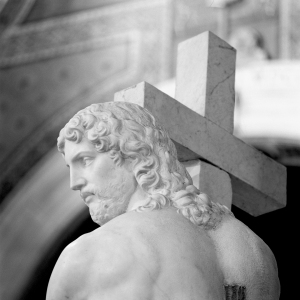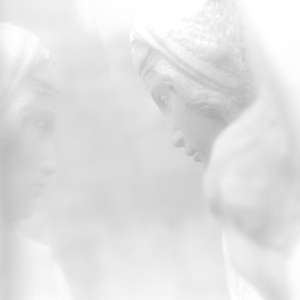Photography
GENESIS
Collection of Michelangelo’s Sculptures
A collection of works with the “miraculous light”, in which Masuura himself overcame the chaos that had been trapped for a long time.
Michelangelo said, “The true work of art lies quietly in the marble. The artist is mindless, only guided by wisdom, wields the chisel and extracts the work from the stone.” Also Masuura photographed Michelangelo’s works as they were. He just pointed the lens in natural light without any technical skill. It is “GENESIS” that appeared there.
-

Miracle of Light I “I am Light”

Miracle of Light I “I am Light”
I can't talk about "GENESIS" without this work. When the artificial lighting was turned off, a streak of light suddenly shot through the stained glass of the rose window in the darkness of the church. It appears on the right hand of the Christ figure and slowly moves to the face. At the end, it became even brighter and made the image stand out like a halo. About 10 minutes in between. I was engrossed in releasing the shutter regardless of the overflowing tears. The priest, who was attending this moment of ecstasy, prayed, "The light that came just for you. May you be blessed by that light."
-

Golgotha IV “Miracle of the Cross”

Golgotha IV “Miracle of the Cross”
A third miracle. It appeared in the laboratory darkroom. Shadows that were invisible when the photograph was taken appeared on both sides of Christ during development. The Bible says that at the time of Christ's crucifixion, two sinners were executed at the same time. I was gooseflesh all over for a while at emerging the composition of the lore as it was. This statue, believed to be Michelangelo's only wooden work, is located in the Church of Santo Spirito in Florence. The collection of Casa Buonarroti also contains wood carving studies, including a crucifixion of Christ, but the artist's style is still unclear.
-

Mirror

Mirror
Relief of the Madonna and Child in the Bargello Museum. Since there is protective glass in front, I turned the lens from the side. How beautiful and fragile the profile of Mary is! And her profile reflected on the glass surface is supposed to be the same face, but a different expression (strength) appears. Which one is her true form...?
-

Madonna of Bargello

Madonna of Bargello
This is a front view of the previous work titled "Mirror". The infant Christ rests peacefully in his mother's arms.
-

Face of Light II

Face of Light II
The second miracle happened when I was photographing the statue of Moses in the church of San Pietro in Vincoli in Rome. The statue is placed in the back of the transept, so little natural light reaches there. However, when I set up the camera, Moses' face began to shine. Because the light of the setting sun reflected on the marble floor lit up the face of the statue. The Old Testament tells us that Moses' face was shining when he came down from Mount Sinai, after speaking with Lord and carrying the two stone tablets of Commandments. I was amazed at this coincidence.
-

Citizen of Rome III

Citizen of Rome III
Bust of "Brutus" in the Bargello Museum. It is based on the betrayal of a Roman politician who plotted the downfall of Julius Caesar. The real model is Lorenzino de Medici. He was compared to Brutus for the assassination of his distant cousin Alessandro, who was called a tyrant.
-

Room with Angel[s]

Room with Angel[s]
An angel with a candelabra adorning the Arc of St. Domenico in the church dedicated to this saint in Bologna. The angel on the right side is Michelangelo's work.
-

Angel V

Angel V
Angel of the Arc of St. Domenico.
-

Bacchus I

Bacchus I
The god of wine in Roman mythology, exhibited at the Bargello Museum in Florence. Its skin appears soft, even though it is actually marble. His plump body seems to represent a fat Bacchus from drinking too much wine.
-

Hand of Bacchus

Hand of Bacchus
This work was used as an invitation for a personal exhibition at Casa Buonarroti in Florence (Michelangelo Museum). The museum director said, "I never realized that the statue of Bacchus had such beautiful hand…"
-

Bacchus II

Bacchus II
God of wine in Roman mythology. It is on display at the Bargello Museum in Florence. Bacchus, photographed in natural light, is enveloped in a soft glow, expressing soft and relaxed lines.
-

Face of “Night”

Face of “Night”
In the church of San Lorenzo, the family temple of the Medici family, which boasted prosperity in Florence, there is the Medici Chapel, where Michelangelo was commissioned to sculpt the sacristy. The carvings are of a pair of men and women of all ages and are called "Day" and "Night", and "Dawn" and "Twilight" respectively. The woman in "Night" is already past middle age and her body lines are distorted and crumbling, but the expression on her face is gentle and peaceful. It was a night when a person's life was transposed into a single day, and I turned my lens to the surprise given by her rich expressions.
-

Face of “Dawn” I

Face of “Dawn” I
A work that makes a pair with "Face of Night". "Dawn" is a statue of a young woman, as the name suggests, and her body line is beautiful and in a seductive pose, but her expression is troublesome.
-

Prayer I

Prayer I
Monument to Lorenzo the Magnificent and his brother Giuliano di Medici in the Medici Chapel. It consists of three sculptures with the Madonna and Child in the center and saints on either side. The left and right saints are sculptures of Michelangelo's disciples. The theme of the Virgin Mary and the Child (Jesus) have been the subject of many artists, including Michelangelo. The expression of Maria holding her child with one hand is infinitely grace and sad.
-

Chained Person II

Chained Person II
"The Dying Slave" at the Louvre Museum. His face looks calm and asleep. In fact, he is about to fall into an eternal sleep called "death", which is the only way to liberation for him. For a slave, death may not be a pain, but a solace that finally comes.
-

Hand of God

Hand of God
Hand of “David” in the Accademia Gallery in Florence. I pointed the lens at his hand spontaneously by his strength. Created by Michelangelo, who was called "the hand of God", David is dignified and beautiful, right down to his fingertips. "I can see the hot blood running under his skin...", Poet Goichi Matsunaga once said when he gazed this work (photo).
-

David of Florence

David of Florence
The statue of “David” is one of Michelangelo's greatest masterpieces, comparable to the “Pieta” in Vatican. I had to wait until nightfall to take pictures due to its fame and so many visitors,. I took this picture on a dark moonless night with only one candle light,
imagining Michelangelo striking a chisel at night with only the light of a candle... The shadow created by the candlelight emphasized the strength of the statue of David, which was created as the patron deity of the Florentine Republic at that time. The shadow represents the ruling leadership of the Medici family, and David's radiant body is the symbol of liberty and democracy that bounces off it. -

Pensive I

Pensive I
A statue of David, also known as Apollo, god of art, at the Bargello Museum in Florence. As for David, it is a completely different work from "David of Florence". Could the sorrowful look be due to the fact that the client was the enemy commander who executed Michelangelo's best friend?
-

Pensive II

Pensive II
The same statue of David (or Apollo) as Pensive I.
-

Miracle of Light VI “Follow me”

Miracle of Light VI “Follow me”
The light that suddenly shines over Christ's head through the broken rose window in the ceiling. This light led me to the second (Face of Light) and third (Golgotha) miracles.
Click on the photo to see the individual portfolios.
